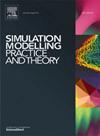Edge-computing-enabled hybrid and multi-objective geographic routing for mesh IoT networks: An IMOGWO-based approach
IF 3.5
2区 计算机科学
Q2 COMPUTER SCIENCE, INTERDISCIPLINARY APPLICATIONS
引用次数: 0
Abstract
Due to their robustness and resource limitations, IoT objects pose several multi-objective optimization challenges, making routing in mesh IoT networks a critical issue. Meanwhile, meta-heuristic and multi-objective optimization approaches provide promising results. This paper proposes a novel geographic, hybrid and multi-objective routing method for IoT mesh networks. Routing is formulated as an optimization problem with multiple objective functions. The proposed Improved Multi-Objective Gray Wolf Optimizer (IMOGWO) meta-heuristic is applied between communicating objects in a distributed manner to solve and optimize routing decisions. The work presents the first application and evaluation of IMOGWO to a real-world problem, specifically routing in IoT mesh networks. Combined IoT simulations (using both real and simulated nodes) are performed to evaluate the introduced approach and show its effectiveness in comparison to other existing routing methods, including MOGWO-based routing, an AcNSGA-III-based QoS routing and a BFOA-based geographic routing algorithm. Results indicate that the proposed approach enhances network performance. Particularly, IMOGWO increases the stability period by 9.30% compared to MOGWO, 20.51% compared to AcNSGA-III and 38.24% compared to BFOA. In addition, it ensures a better packet delivery ratio (92.2%). Furthermore, it maintains a lower average transmission latency (1.93s) than AcNSGA-III and BFOA. These improvements, validated through inferential statistical tests, demonstrate that IMOGWO optimizes routing for IoT mesh networks effectively.
支持边缘计算的网状物联网网络混合多目标地理路由:基于imogwo的方法
由于其鲁棒性和资源限制,物联网对象提出了几个多目标优化挑战,使得网状物联网网络中的路由成为一个关键问题。同时,元启发式和多目标优化方法也提供了令人满意的结果。提出了一种新的物联网网状网络的地理、混合和多目标路由方法。将路径问题表述为具有多目标函数的优化问题。提出的改进多目标灰狼优化(IMOGWO)元启发式算法在通信对象之间以分布式方式求解和优化路由决策。这项工作提出了IMOGWO在现实世界问题上的首次应用和评估,特别是物联网网状网络中的路由。结合物联网仿真(使用真实和模拟节点)来评估所引入的方法,并与其他现有路由方法(包括基于mogwo的路由,基于acnsga - iii的QoS路由和基于bfoa的地理路由算法)进行比较,显示其有效性。结果表明,该方法提高了网络性能。其中,IMOGWO比MOGWO增加了9.30%,比AcNSGA-III增加了20.51%,比BFOA增加了38.24%。此外,它还保证了更好的数据包分发率(92.2%)。与AcNSGA-III和BFOA相比,其平均传输延迟(1.93s)较低。通过推理统计测试验证的这些改进表明,IMOGWO有效地优化了物联网网状网络的路由。
本文章由计算机程序翻译,如有差异,请以英文原文为准。
求助全文
约1分钟内获得全文
求助全文
来源期刊

Simulation Modelling Practice and Theory
工程技术-计算机:跨学科应用
CiteScore
9.80
自引率
4.80%
发文量
142
审稿时长
21 days
期刊介绍:
The journal Simulation Modelling Practice and Theory provides a forum for original, high-quality papers dealing with any aspect of systems simulation and modelling.
The journal aims at being a reference and a powerful tool to all those professionally active and/or interested in the methods and applications of simulation. Submitted papers will be peer reviewed and must significantly contribute to modelling and simulation in general or use modelling and simulation in application areas.
Paper submission is solicited on:
• theoretical aspects of modelling and simulation including formal modelling, model-checking, random number generators, sensitivity analysis, variance reduction techniques, experimental design, meta-modelling, methods and algorithms for validation and verification, selection and comparison procedures etc.;
• methodology and application of modelling and simulation in any area, including computer systems, networks, real-time and embedded systems, mobile and intelligent agents, manufacturing and transportation systems, management, engineering, biomedical engineering, economics, ecology and environment, education, transaction handling, etc.;
• simulation languages and environments including those, specific to distributed computing, grid computing, high performance computers or computer networks, etc.;
• distributed and real-time simulation, simulation interoperability;
• tools for high performance computing simulation, including dedicated architectures and parallel computing.
 求助内容:
求助内容: 应助结果提醒方式:
应助结果提醒方式:


